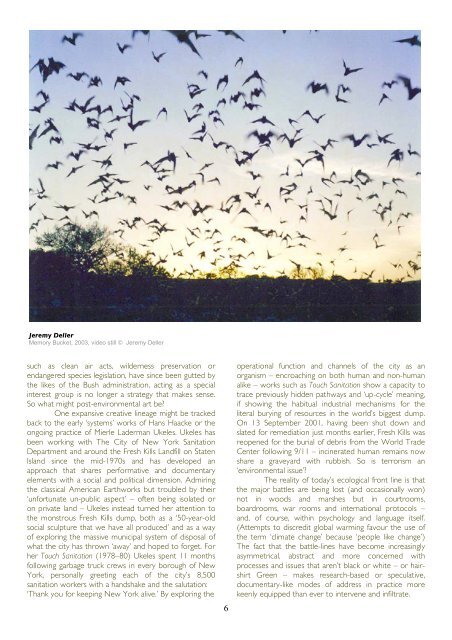M - Antennae The Journal of Nature in Visual Culture
M - Antennae The Journal of Nature in Visual Culture
M - Antennae The Journal of Nature in Visual Culture
You also want an ePaper? Increase the reach of your titles
YUMPU automatically turns print PDFs into web optimized ePapers that Google loves.
Jeremy Deller<br />
Memory Bucket, 2003, video still � Jeremy Deller<br />
such as clean air acts, wilderness preservation or<br />
endangered species legislation, have s<strong>in</strong>ce been gutted by<br />
the likes <strong>of</strong> the Bush adm<strong>in</strong>istration, act<strong>in</strong>g as a special<br />
<strong>in</strong>terest group is no longer a strategy that makes sense.<br />
So what might post-environmental art be?<br />
One expansive creative l<strong>in</strong>eage might be tracked<br />
back to the early ‘systems’ works <strong>of</strong> Hans Haacke or the<br />
ongo<strong>in</strong>g practice <strong>of</strong> Mierle Laderman Ukeles. Ukeles has<br />
been work<strong>in</strong>g with <strong>The</strong> City <strong>of</strong> New York Sanitation<br />
Department and around the Fresh Kills Landfill on Staten<br />
Island s<strong>in</strong>ce the mid-1970s and has developed an<br />
approach that shares performative and documentary<br />
elements with a social and political dimension. Admir<strong>in</strong>g<br />
the classical American Earthworks but troubled by their<br />
‘unfortunate un-public aspect’ – <strong>of</strong>ten be<strong>in</strong>g isolated or<br />
on private land – Ukeles <strong>in</strong>stead turned her attention to<br />
the monstrous Fresh Kills dump, both as a ‘50-year-old<br />
social sculpture that we have all produced’ and as a way<br />
<strong>of</strong> explor<strong>in</strong>g the massive municipal system <strong>of</strong> disposal <strong>of</strong><br />
what the city has thrown ‘away’ and hoped to forget. For<br />
her Touch Sanitation (1978–80) Ukeles spent 11 months<br />
follow<strong>in</strong>g garbage truck crews <strong>in</strong> every borough <strong>of</strong> New<br />
York, personally greet<strong>in</strong>g each <strong>of</strong> the city’s 8,500<br />
sanitation workers with a handshake and the salutation:<br />
‘Thank you for keep<strong>in</strong>g New York alive.’ By explor<strong>in</strong>g the<br />
6<br />
operational function and channels <strong>of</strong> the city as an<br />
organism – encroach<strong>in</strong>g on both human and non-human<br />
alike – works such as Touch Sanitation show a capacity to<br />
trace previously hidden pathways and ‘up-cycle’ mean<strong>in</strong>g,<br />
if show<strong>in</strong>g the habitual <strong>in</strong>dustrial mechanisms for the<br />
literal bury<strong>in</strong>g <strong>of</strong> resources <strong>in</strong> the world’s biggest dump.<br />
On 13 September 2001, hav<strong>in</strong>g been shut down and<br />
slated for remediation just months earlier, Fresh Kills was<br />
reopened for the burial <strong>of</strong> debris from the World Trade<br />
Center follow<strong>in</strong>g 9/11 – <strong>in</strong>c<strong>in</strong>erated human rema<strong>in</strong>s now<br />
share a graveyard with rubbish. So is terrorism an<br />
‘environmental issue’?<br />
<strong>The</strong> reality <strong>of</strong> today’s ecological front l<strong>in</strong>e is that<br />
the major battles are be<strong>in</strong>g lost (and occasionally won)<br />
not <strong>in</strong> woods and marshes but <strong>in</strong> courtrooms,<br />
boardrooms, war rooms and <strong>in</strong>ternational protocols –<br />
and, <strong>of</strong> course, with<strong>in</strong> psychology and language itself.<br />
(Attempts to discredit global warm<strong>in</strong>g favour the use <strong>of</strong><br />
the term ‘climate change’ because ‘people like change’)<br />
<strong>The</strong> fact that the battle-l<strong>in</strong>es have become <strong>in</strong>creas<strong>in</strong>gly<br />
asymmetrical, abstract and more concerned with<br />
processes and issues that aren’t black or white – or hairshirt<br />
Green – makes research-based or speculative,<br />
documentary-like modes <strong>of</strong> address <strong>in</strong> practice more<br />
keenly equipped than ever to <strong>in</strong>tervene and <strong>in</strong>filtrate.












